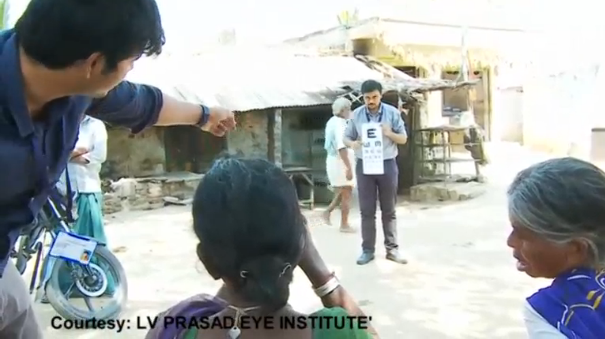
INDIA (Reuters) — An origami-inspired ophthalmic testing device could help democratize eye care for people in isolated communities and developing countries.
The Folding Phoropter consists of just two sheets of card and two small lenses. Following simple instructions, the pieces of card are folded together into two oblong boxes that slide into one another, with the lenses then attached at each end. Resembling a telescope, a patient looks through one end of the phoropter towards an eye chart and by slowly sliding one box out of the other until the chart comes into focus, a quick and accurate eye test can be performed.
The developers believe the device could help millions of people who don’t have ready access to eye care; reducing the amount of people whose lives are blighted by poor vision.
“The scenario right now is that there are a lot of people who do not have access to refractive error screening. And because they can’t do that [get tested] a lot of people go visually impaired,” said industrial designer Ashish Jain.
According to a 2013 report by the World Health Organization, an estimated 153 million people world-wide live with visual impairment due to uncorrected refractive errors. It can have an extremely detrimental effect on people’s lives, including leading to lost educational and employment opportunities, and impaired quality of life.
While it can’t be prevented, diagnosing refractive error correctly means it can be treated with glasses, contact lenses or refractive surgery.
The Folding Phoropter puts the power of self-diagnosis into people’s hands.
“It’s really intuitive to actually use this device, and using that they’ll be able to know if they actually need to go to a visual expert,” said Jain, “you don’t need different lenses; it’s just the whole range you have in a very simple two-lens system.”
It was developed by the Srujana Center for Innovation, L V Prasad Eye Institute, Hyderabad, India. They are currently performing field tests of the device to optimise its design and ease of use.
“What research we are actually trying to do is to know how robust is the device and how accurate is the device. Once we have the data for that we’ll start deploying it in our own network, and this will actually help us in validating it, create better designs. And I think the design will keep on evolving, and that’s the idea. So we keep on evolving and we keep on spreading it out and give the best to the customer,” said Jain.
Preliminary data collected from around 100 subjects indicated a strong correlation between the Folding Phoropter’s readings and standard eye tests, added Jain.
With the cost of a single Folding Phoropter coming in at under half a dollar, Jain said the device could eventually help millions of people.
“We should be able to reach at least 50 million people, and this will actually help us build this product in a better way,” he said.
To coincide with World Sight Day on October 13 the Folding Phoropter was awarded $50,000 (USD) in funding, winning second prize in the inaugural Clearly Vision Prize; part of the Clearly campaign that seeks to address the challenges brought about by poor vision and accelerate innovation in eye care.







